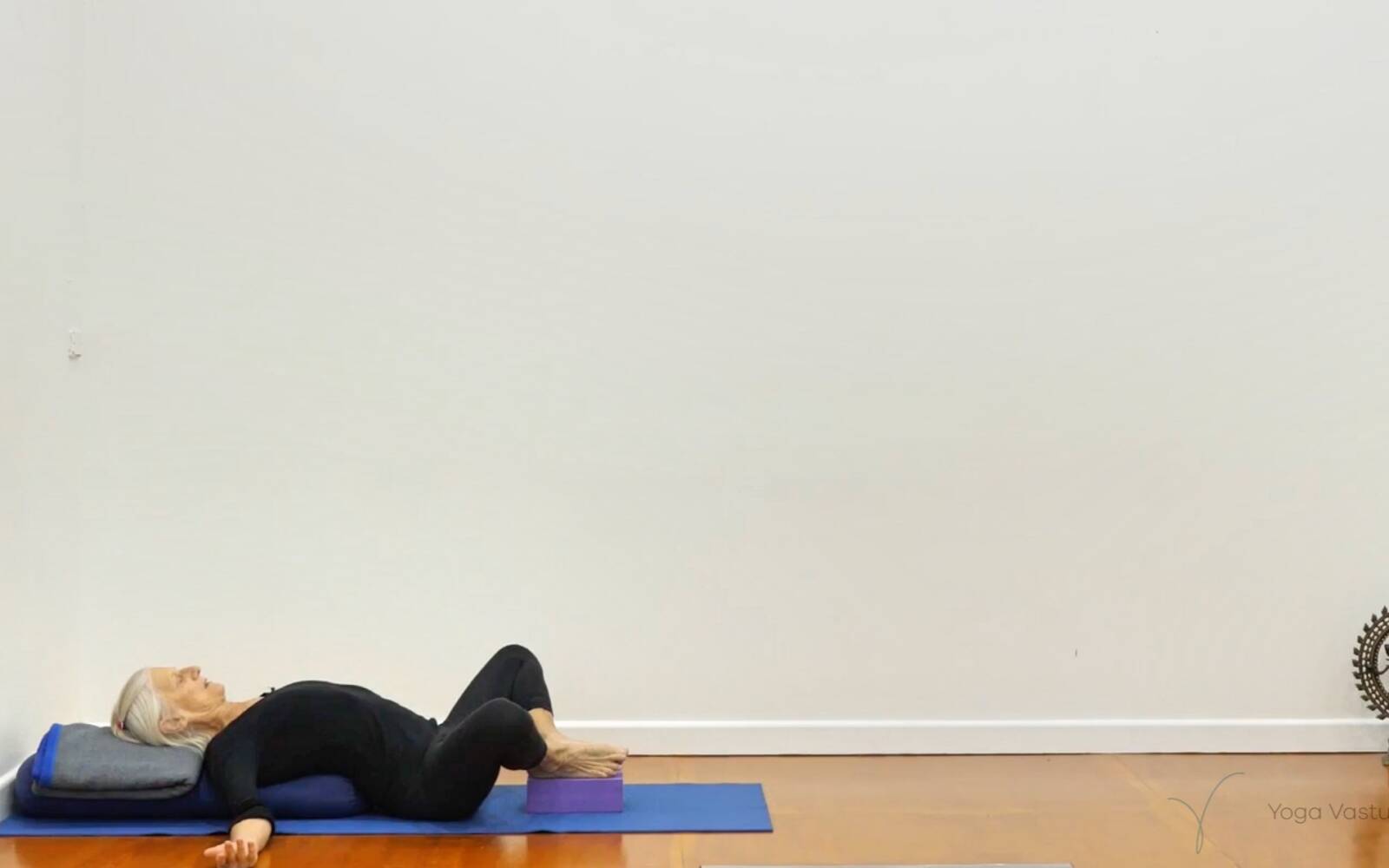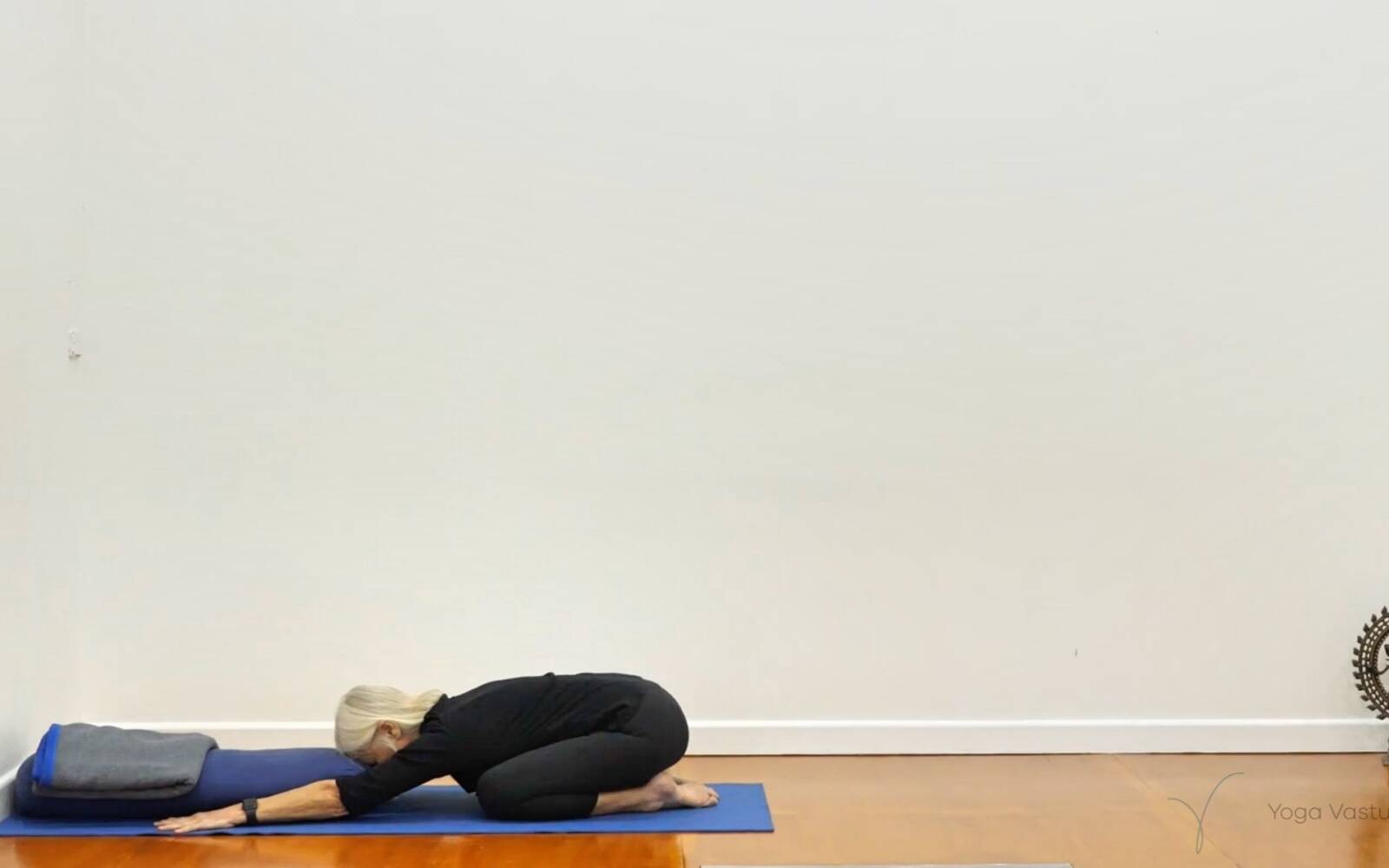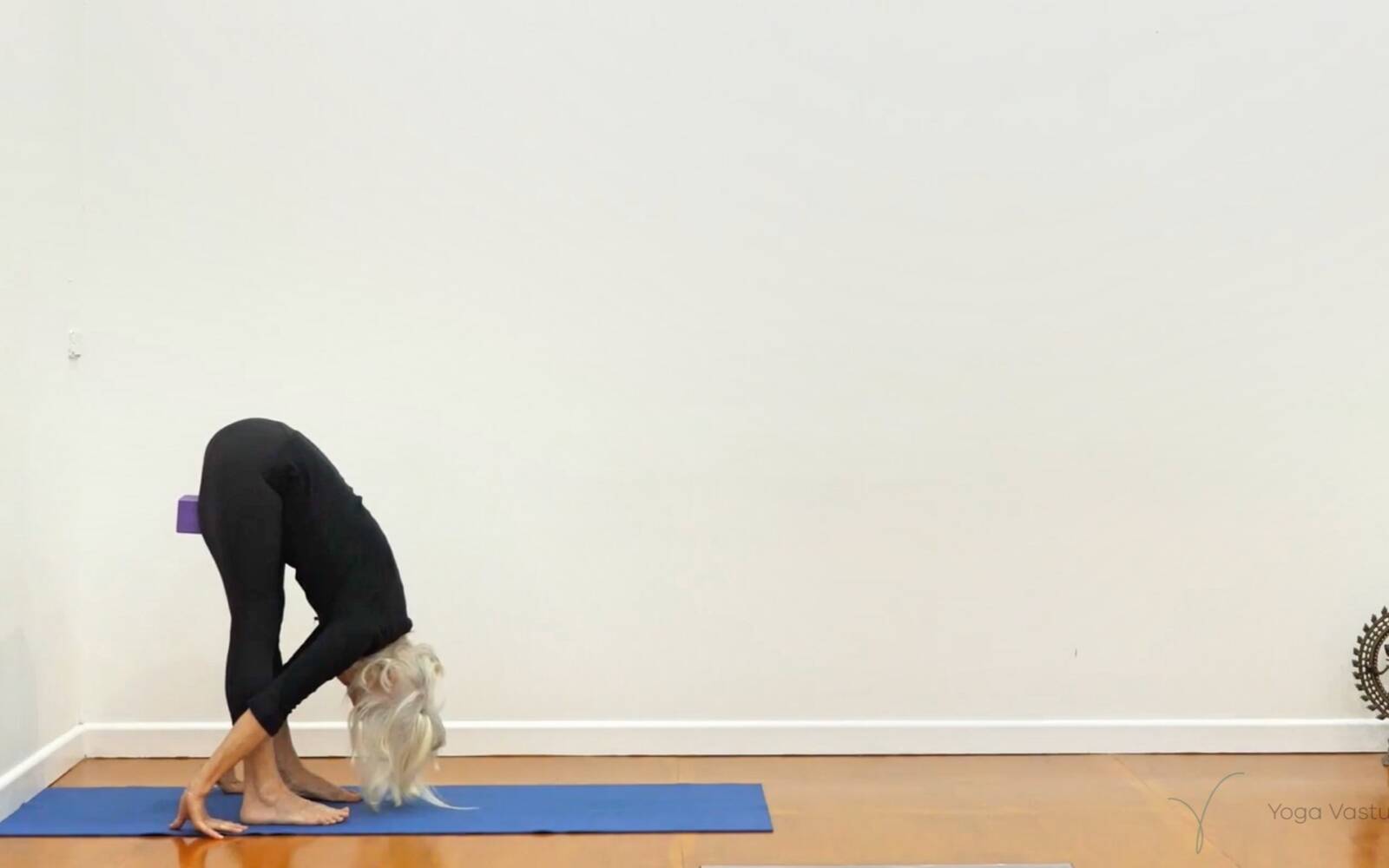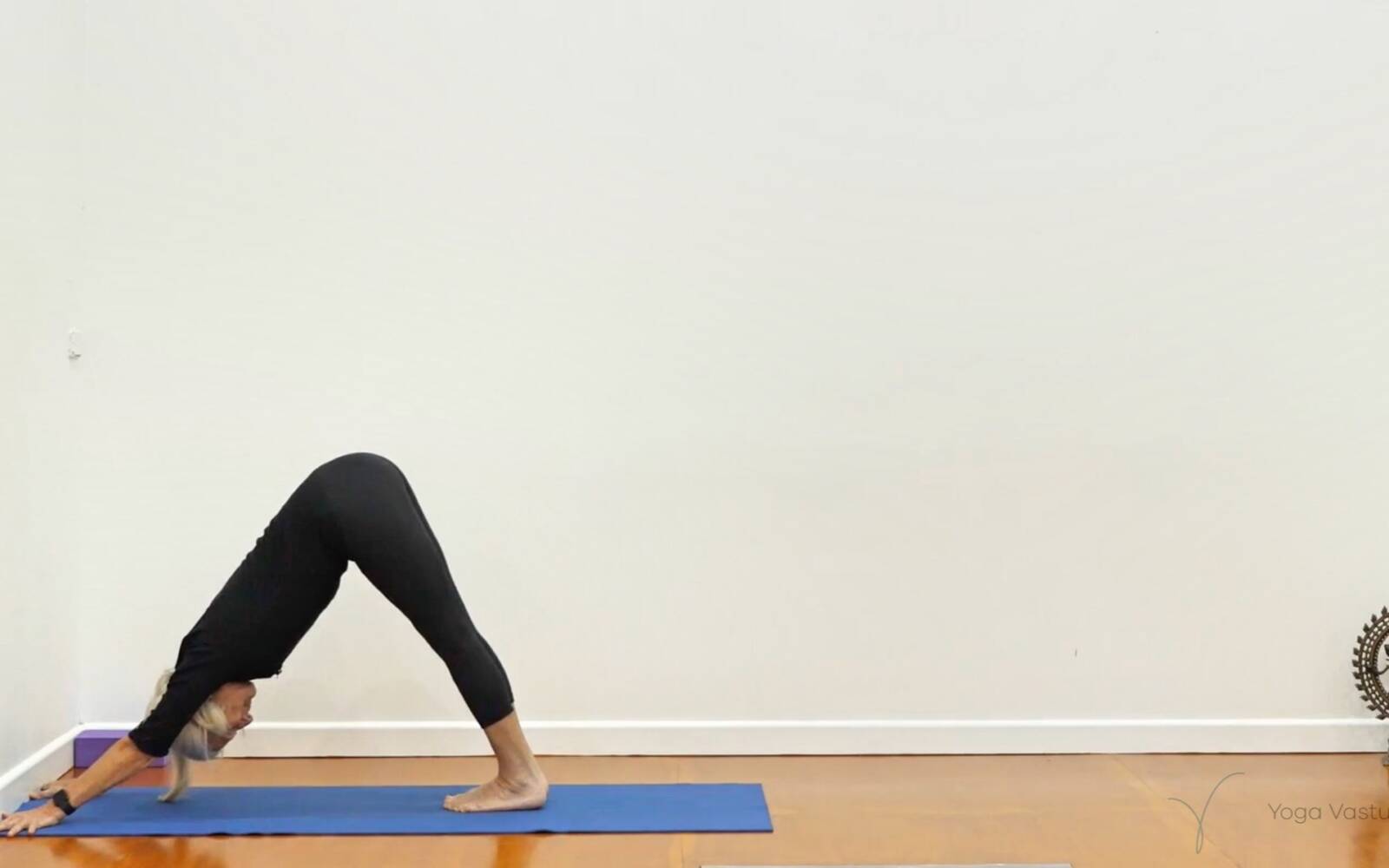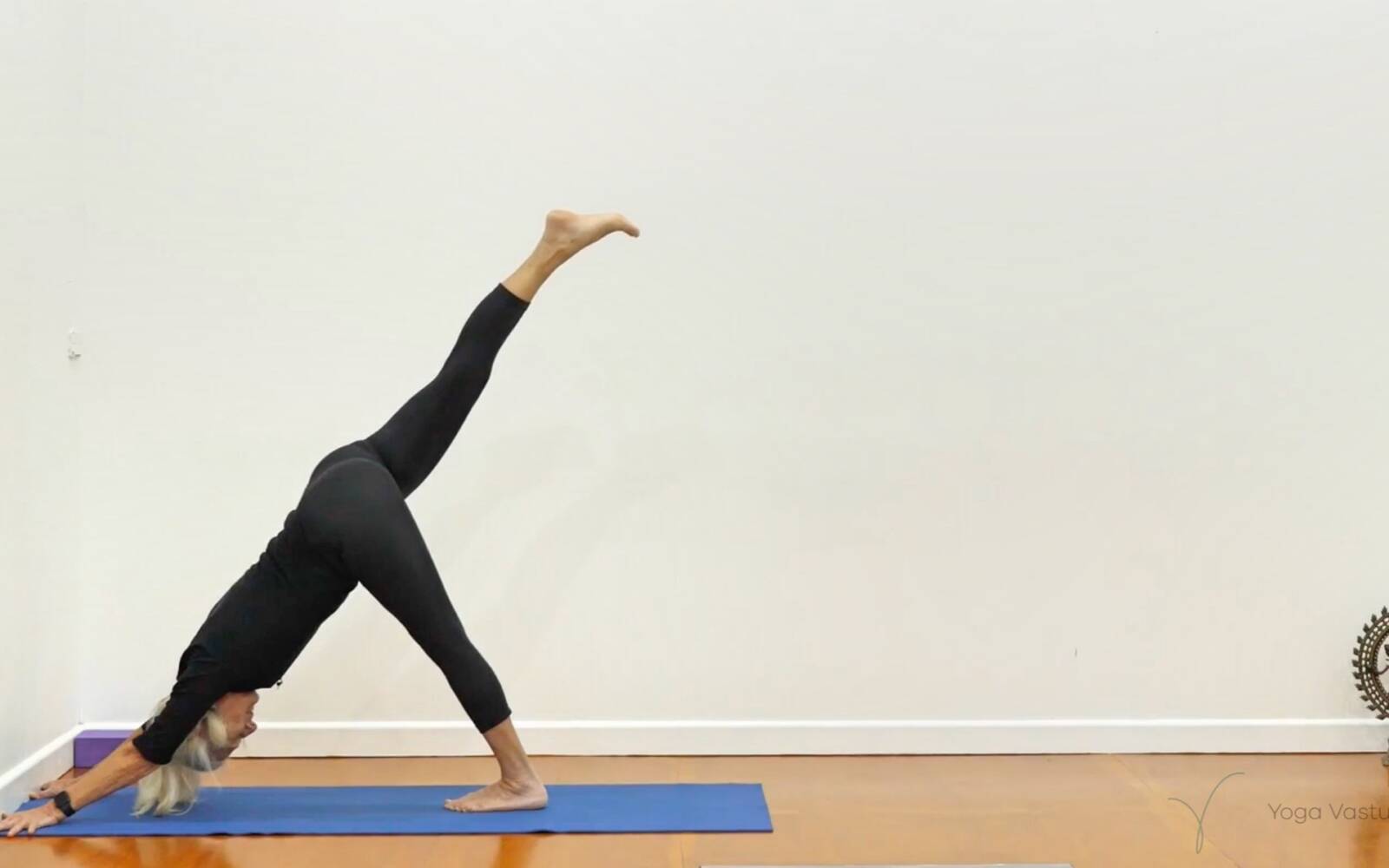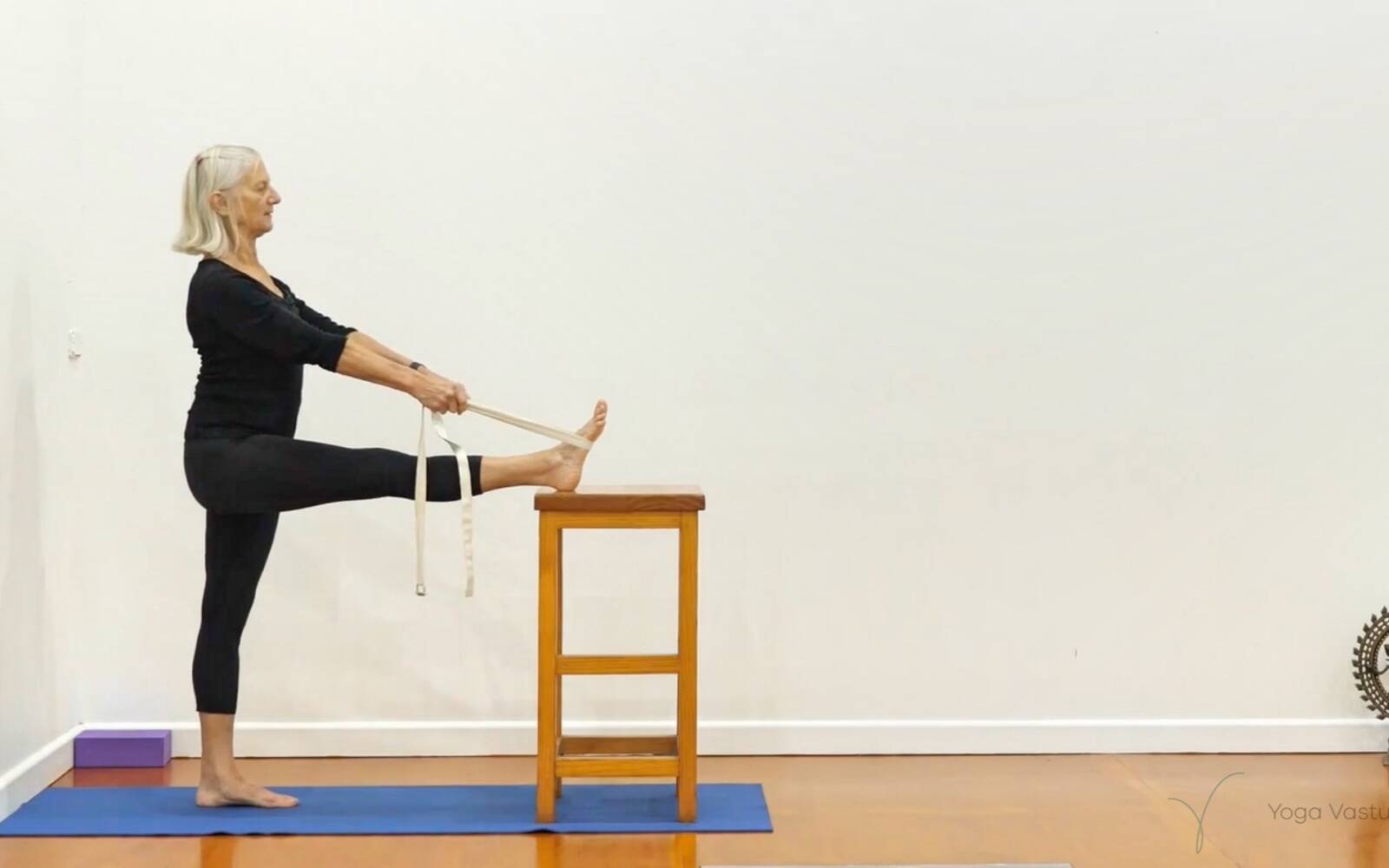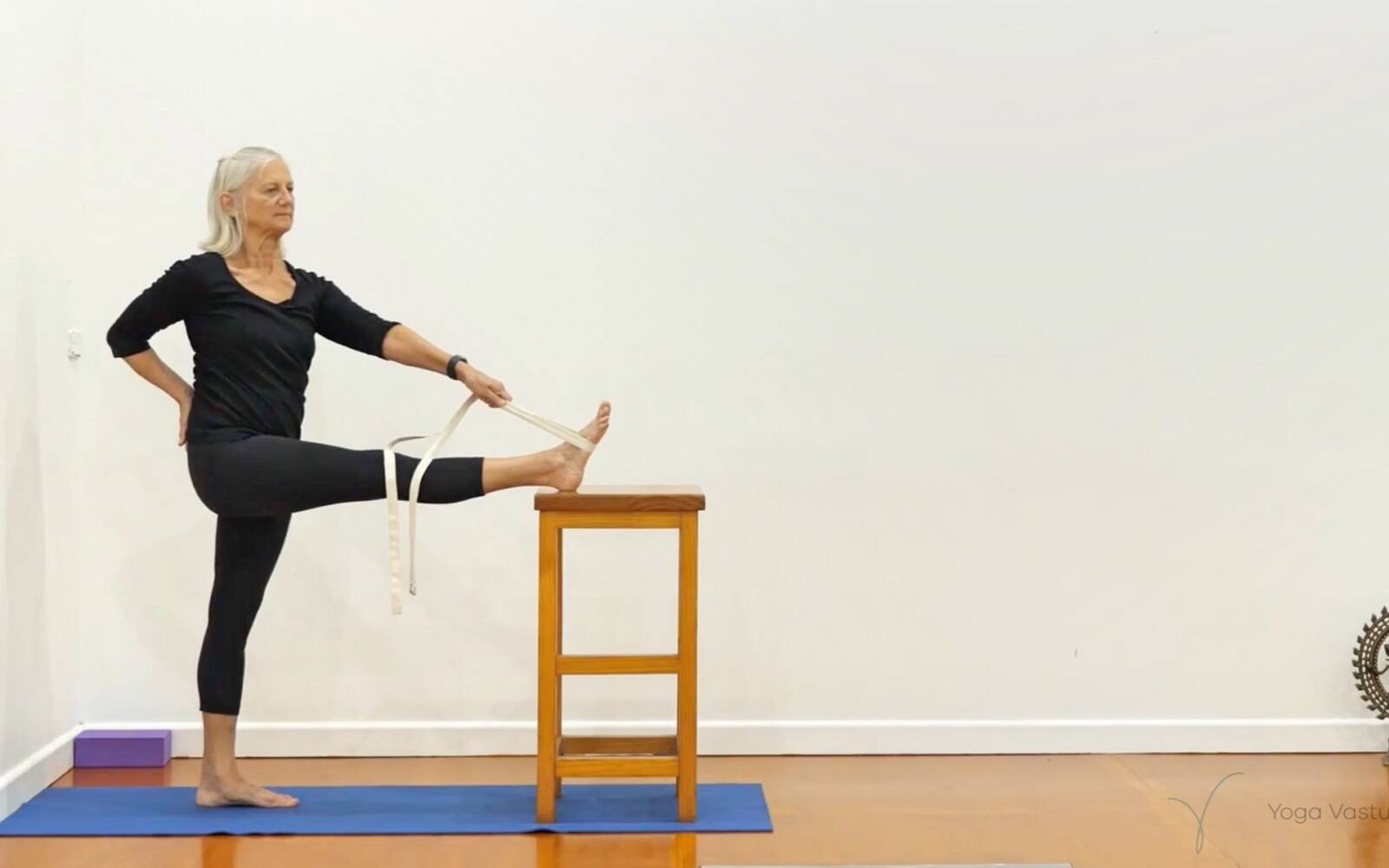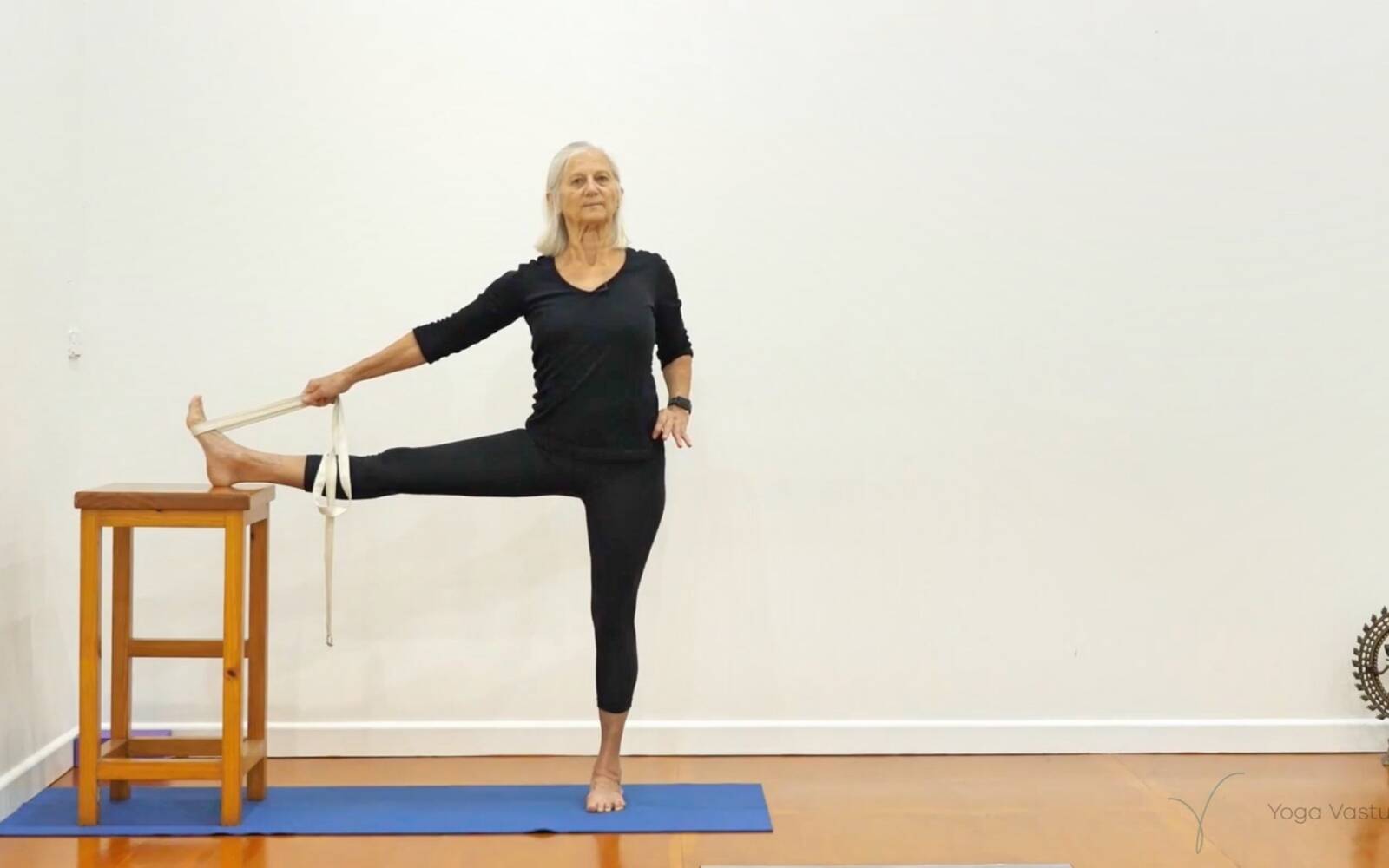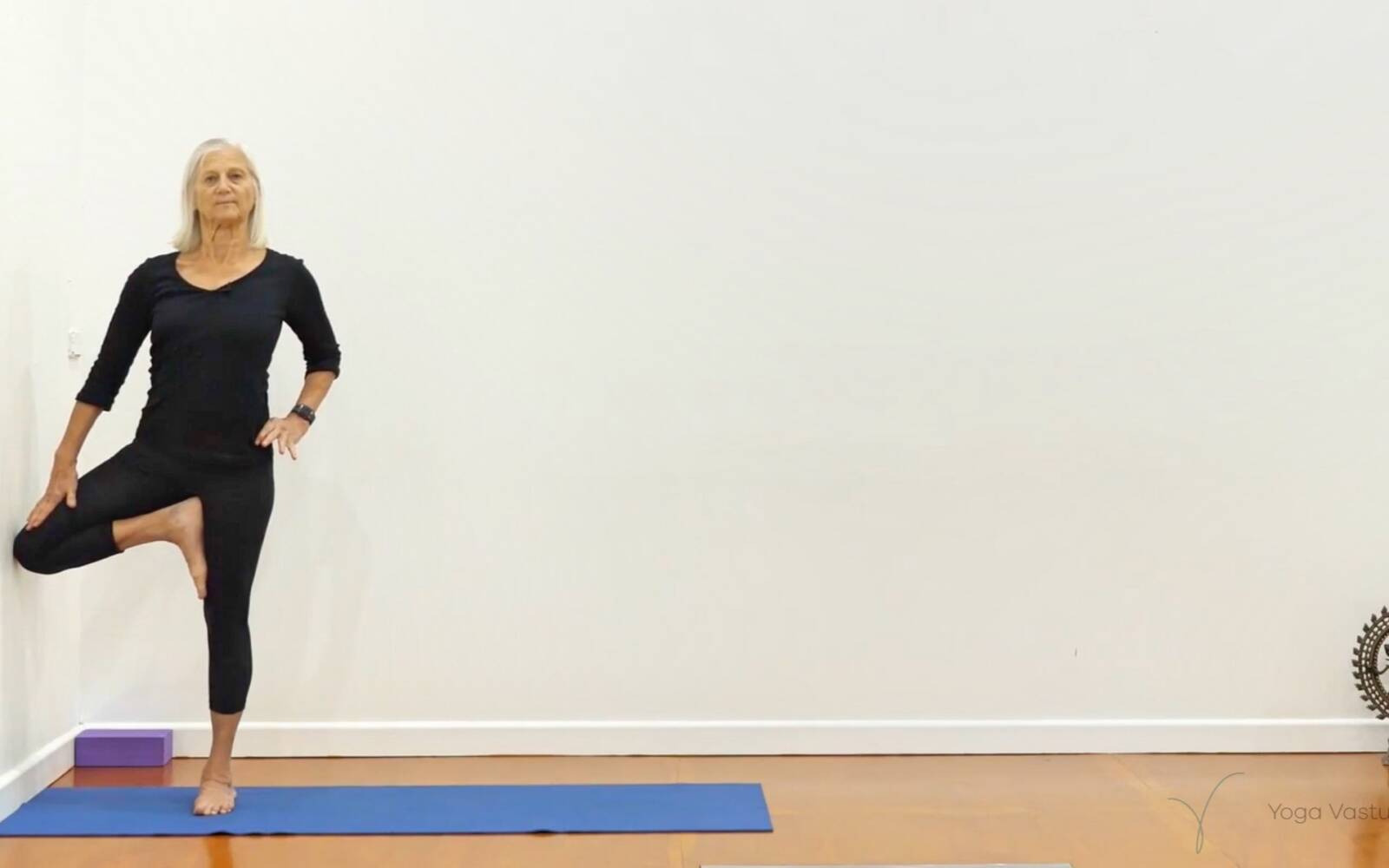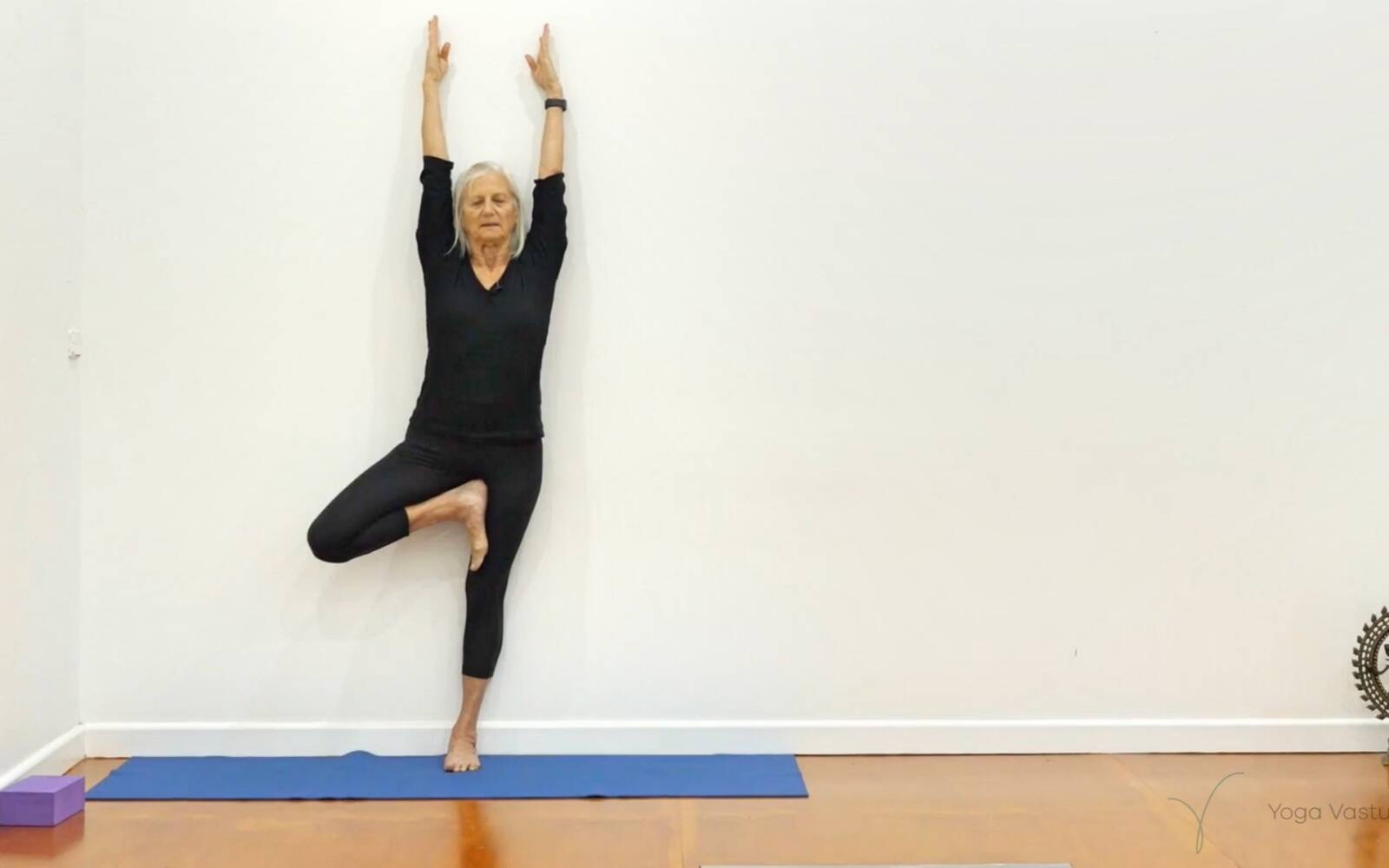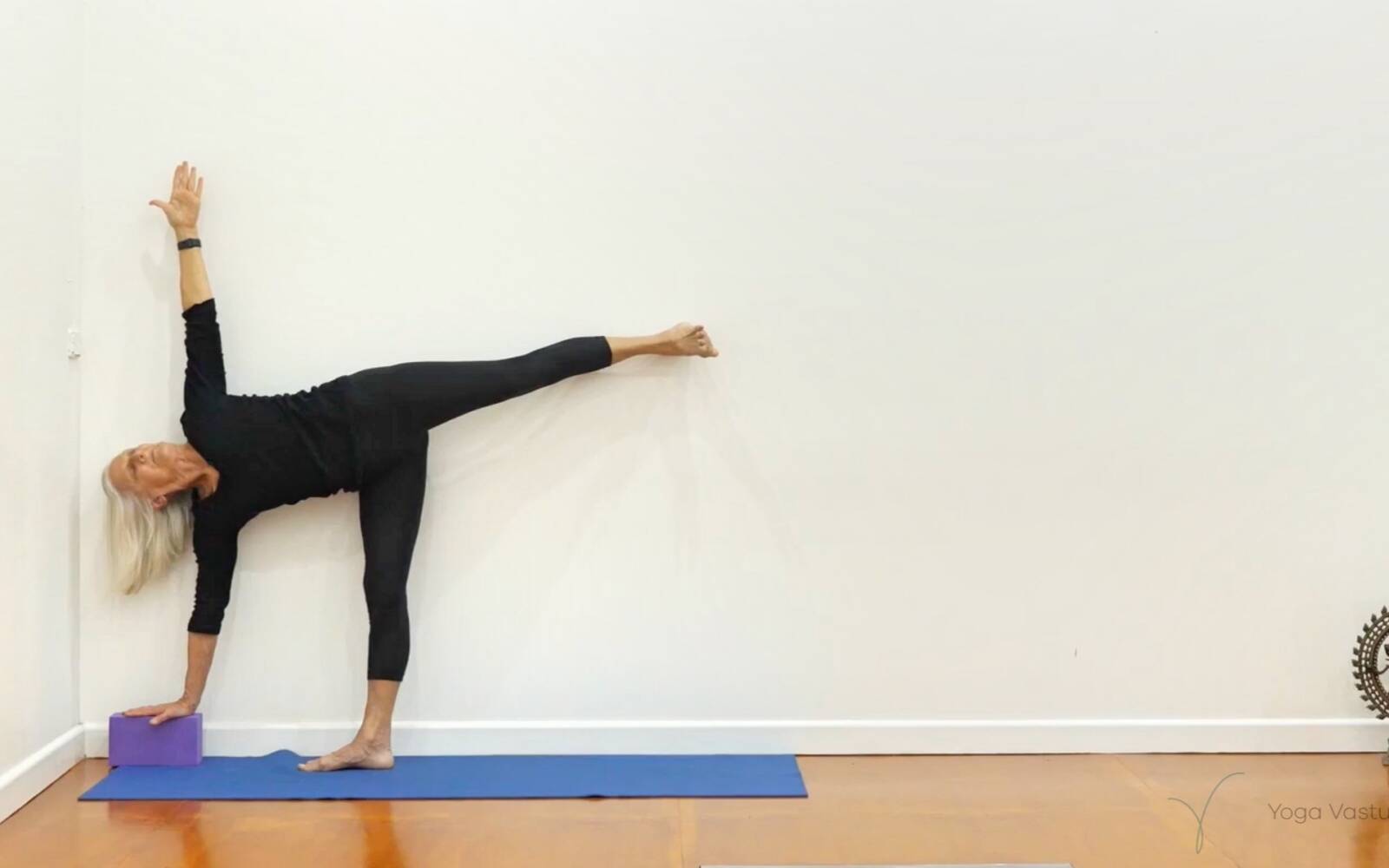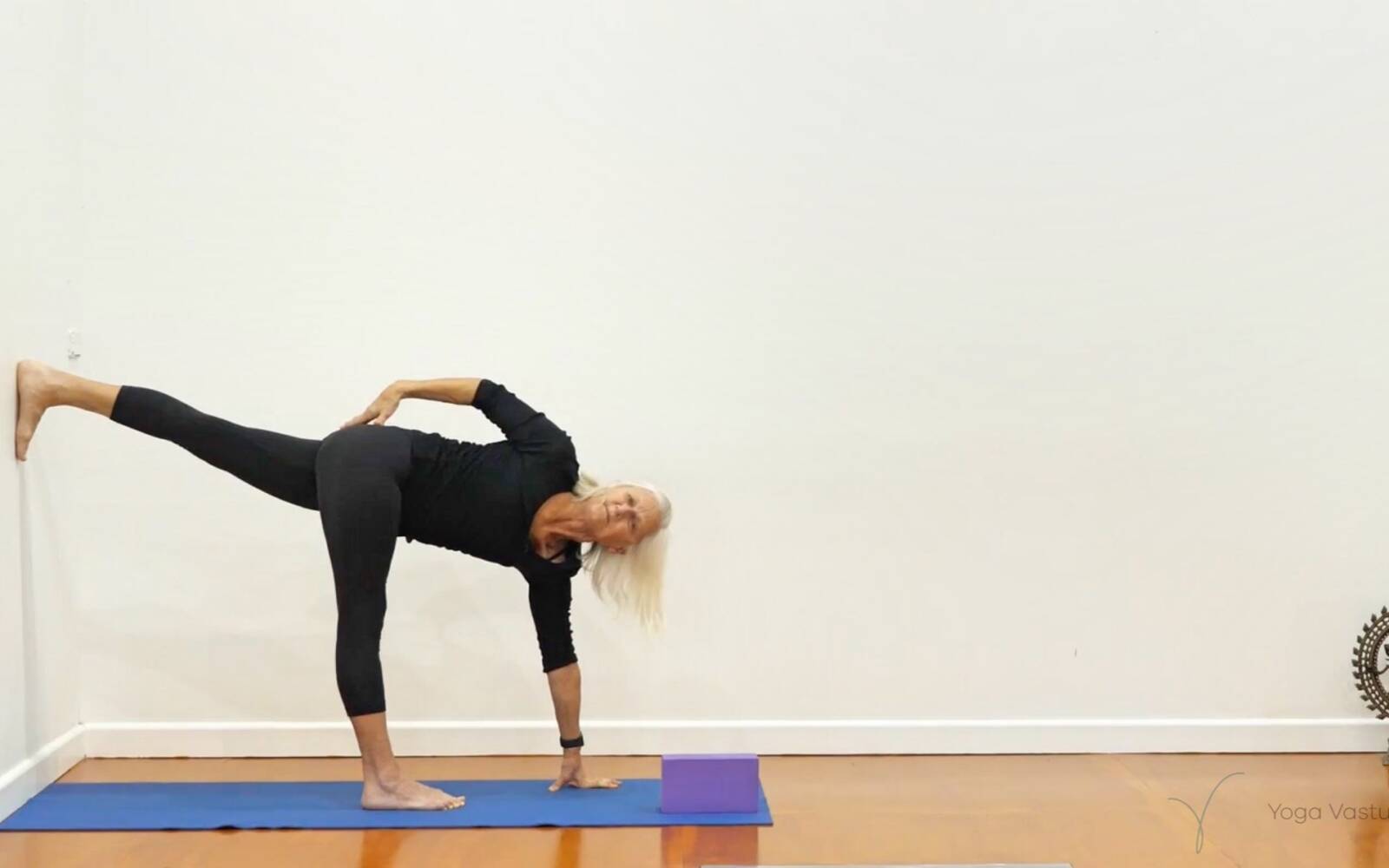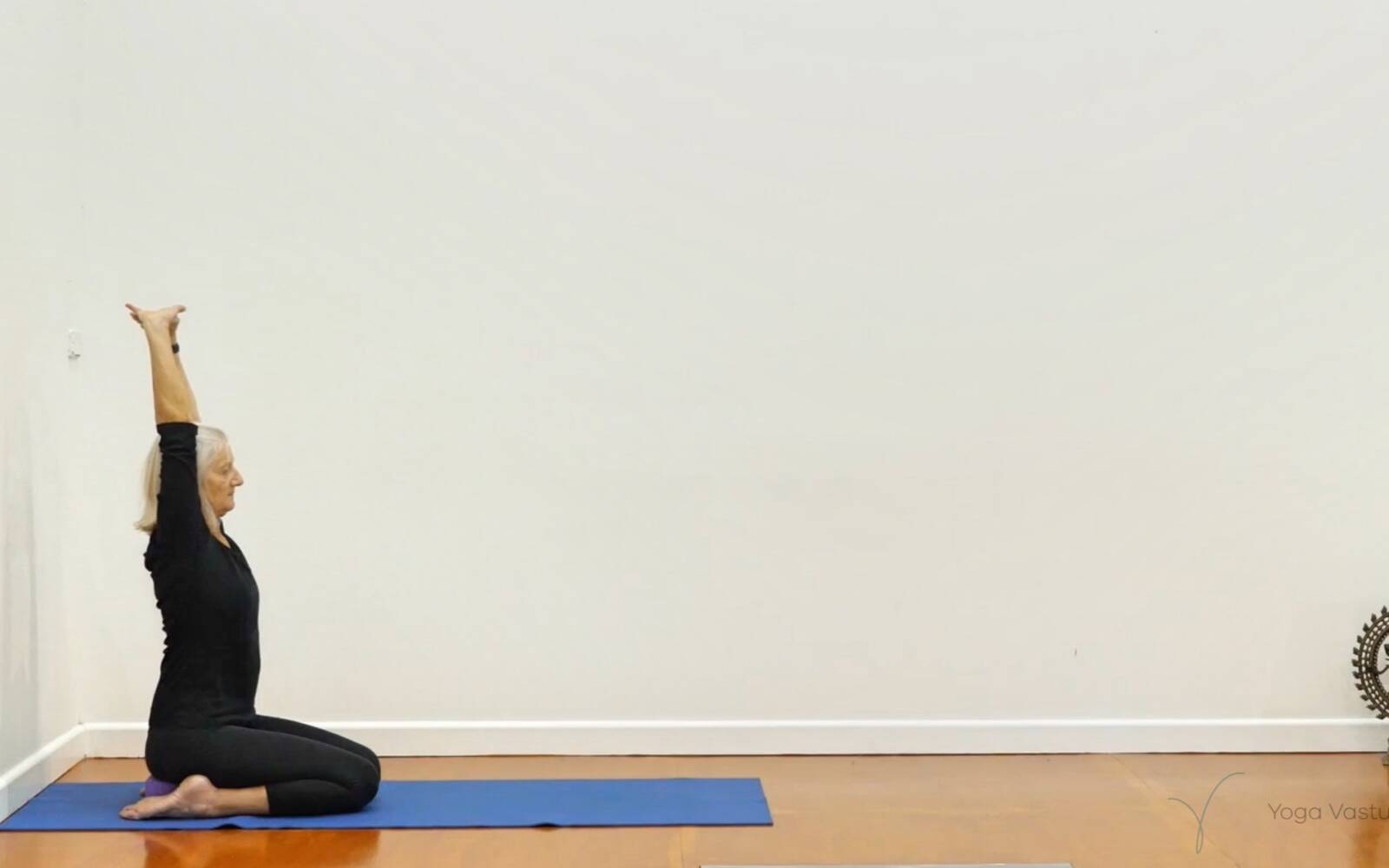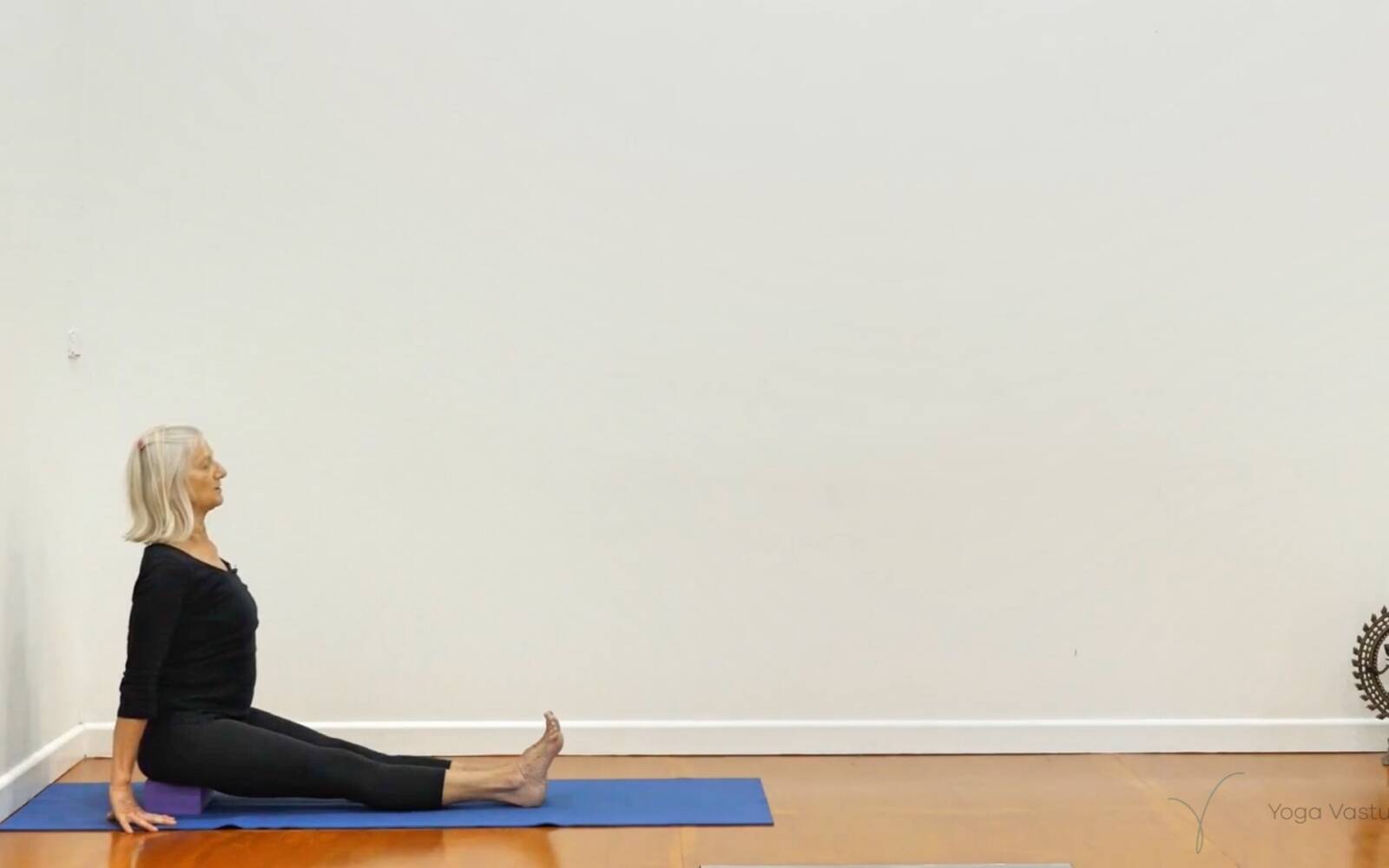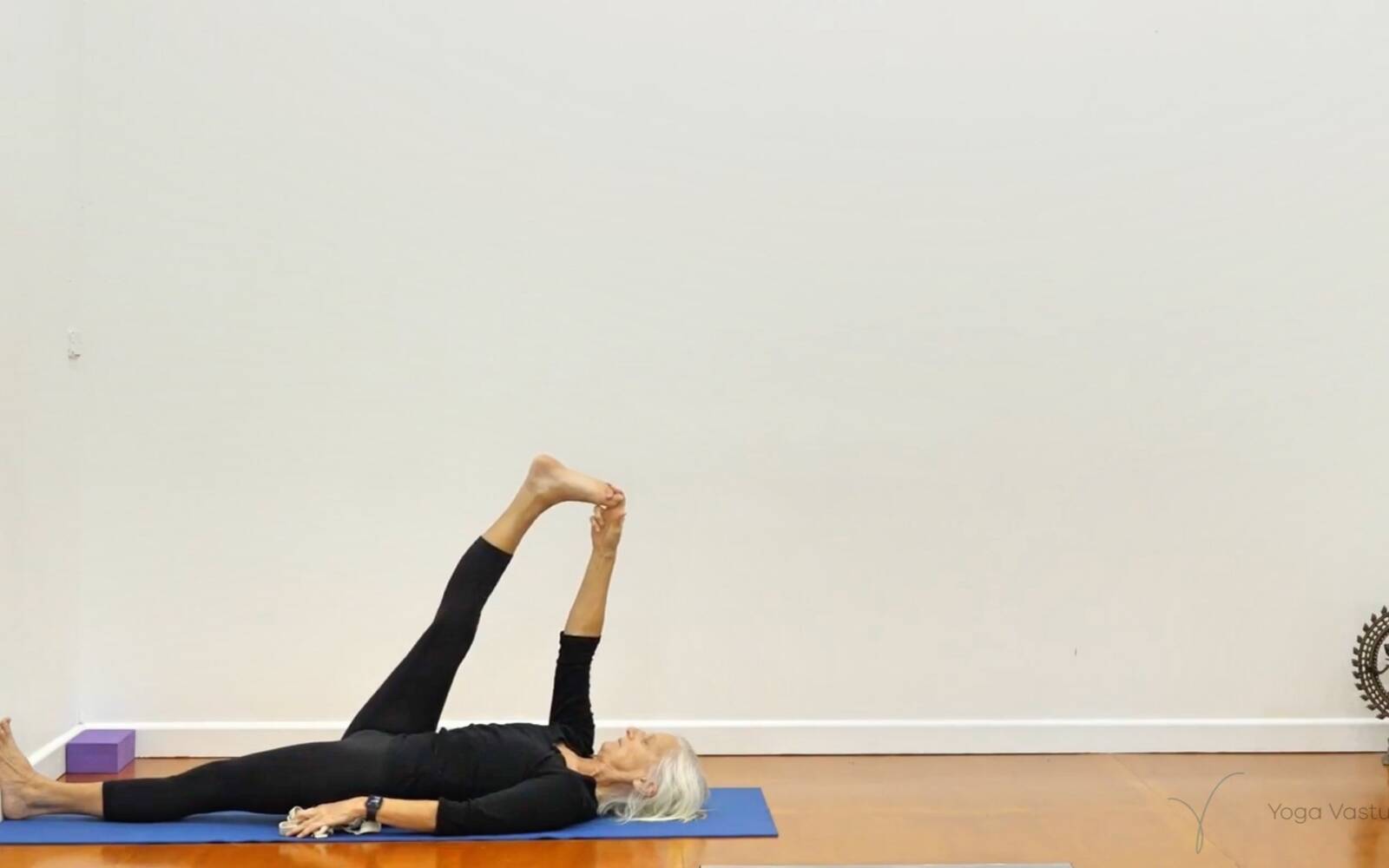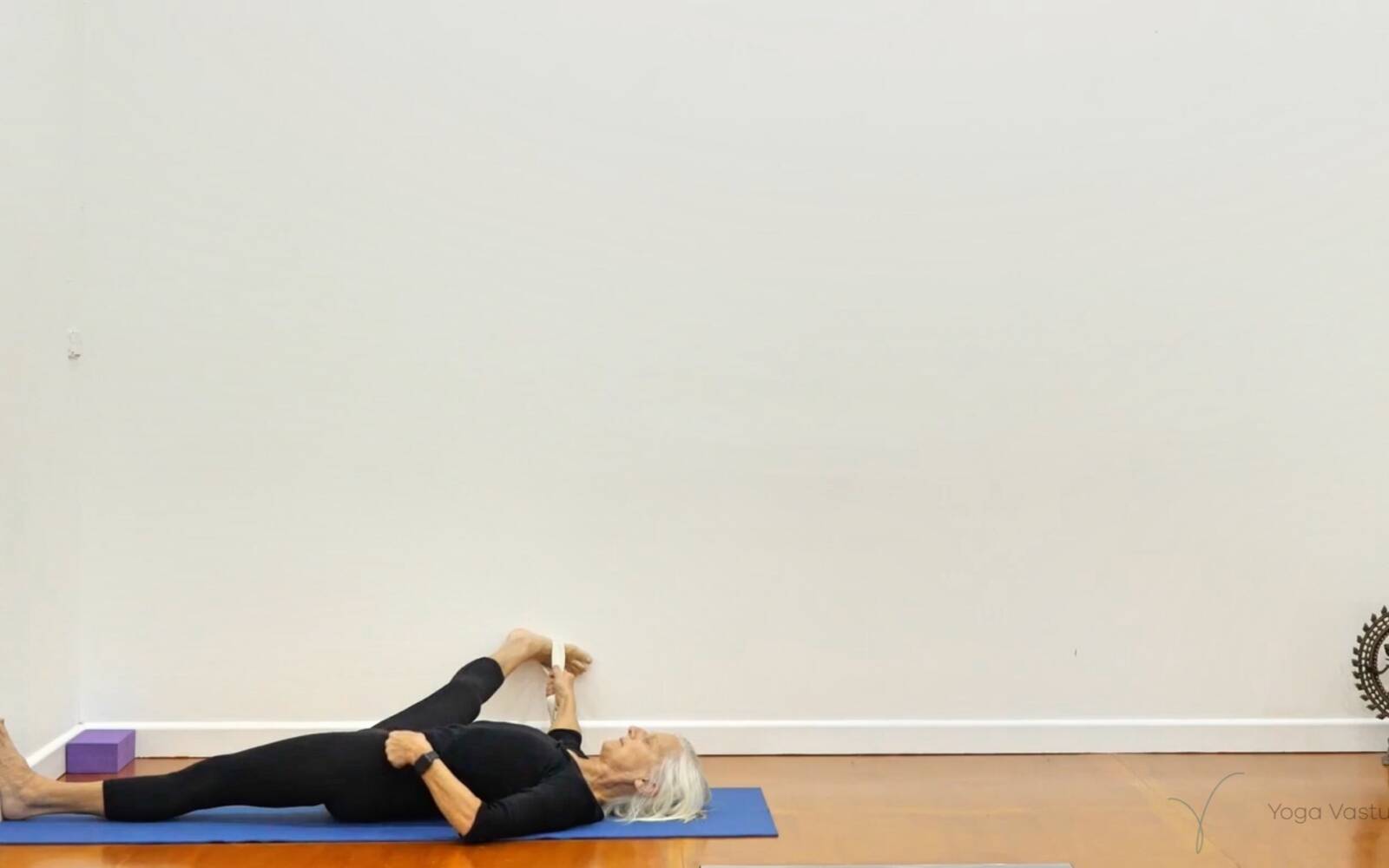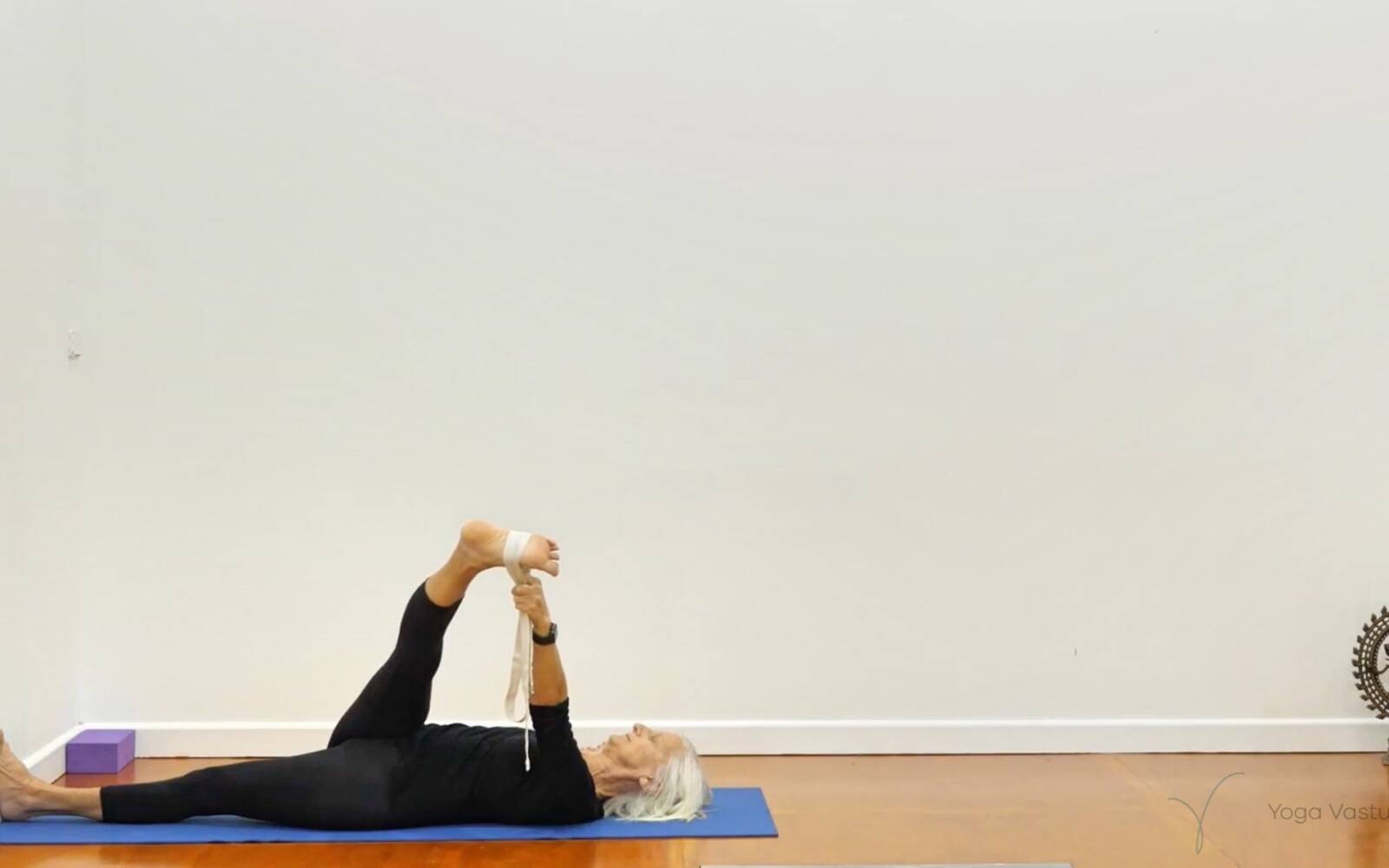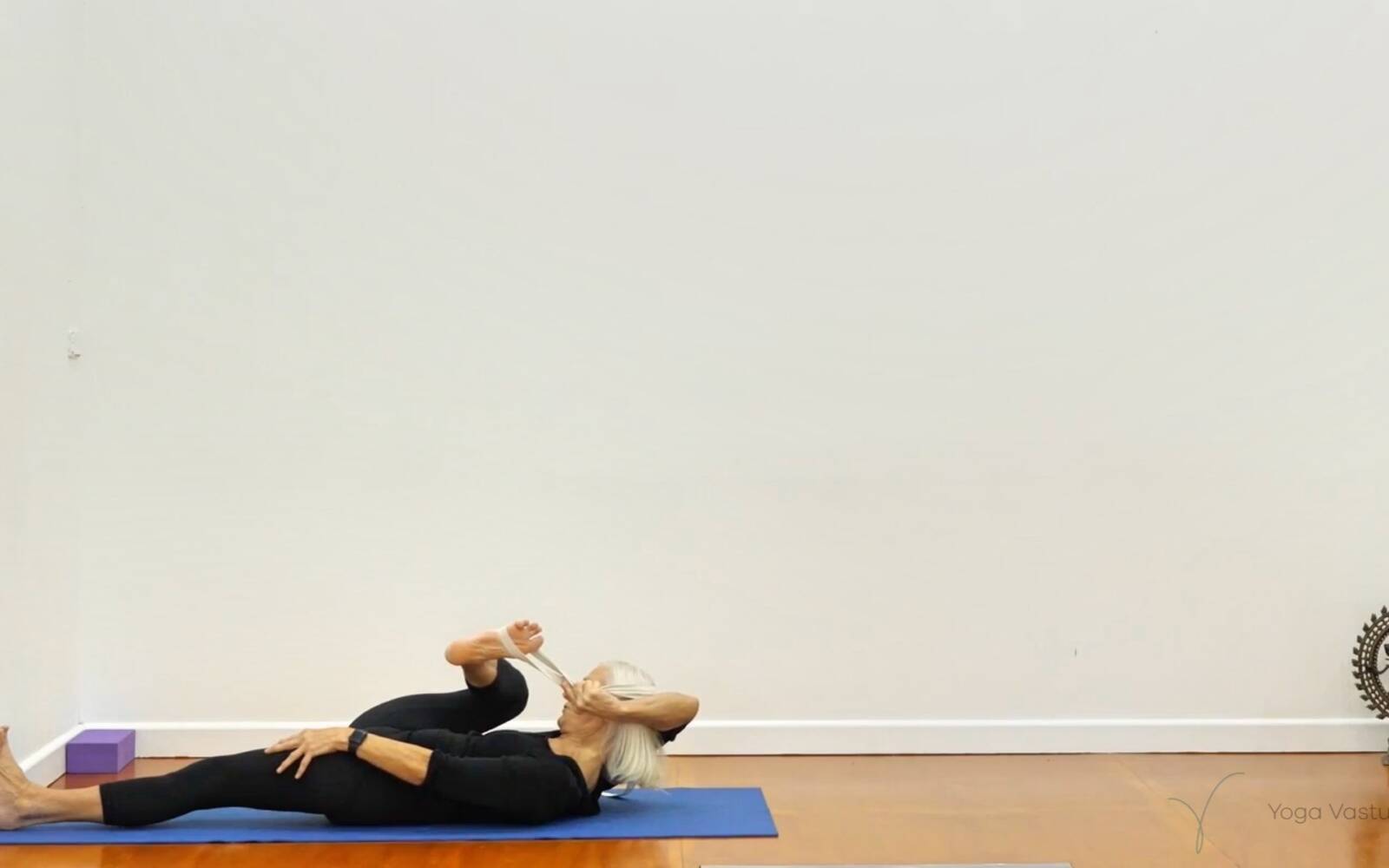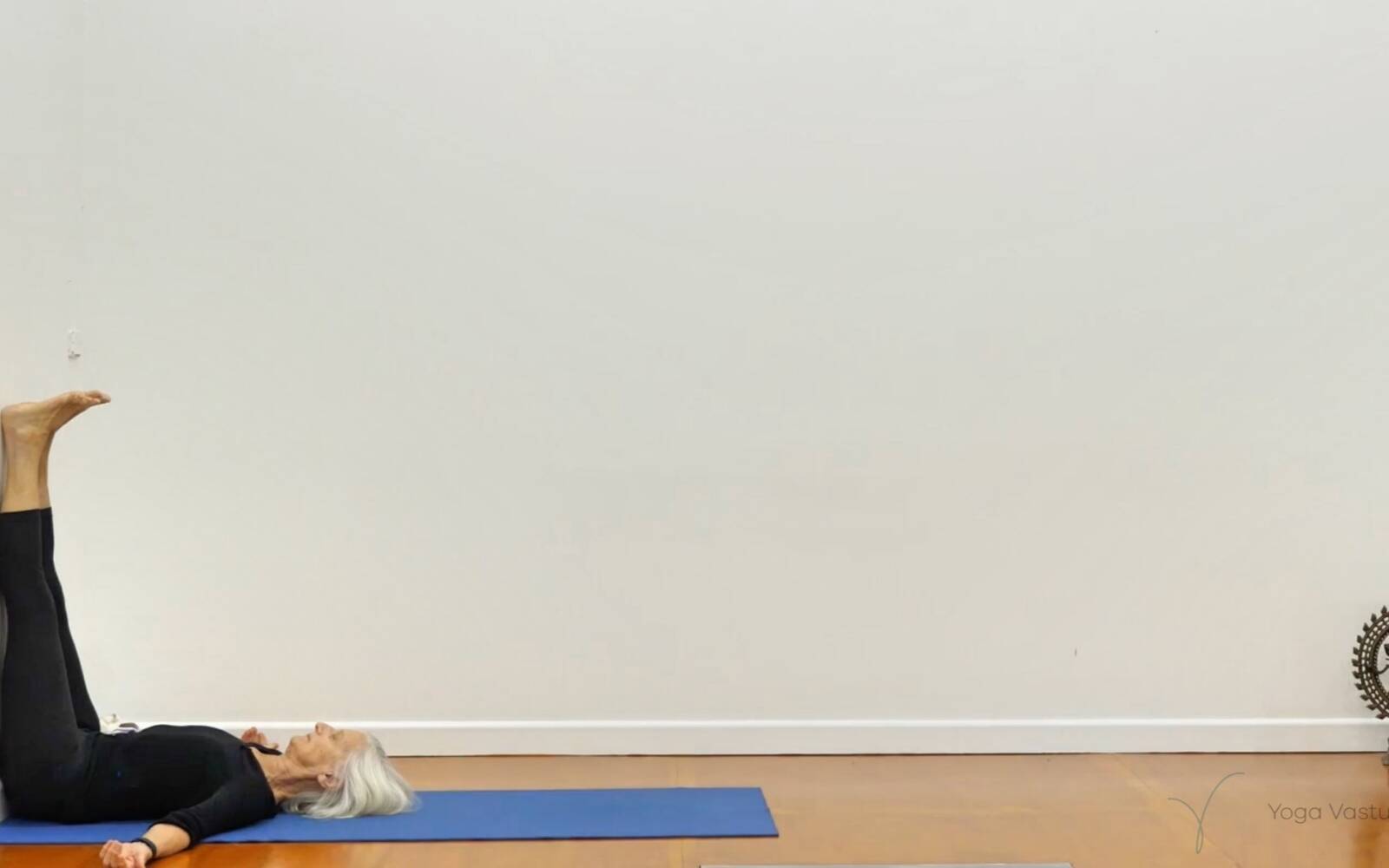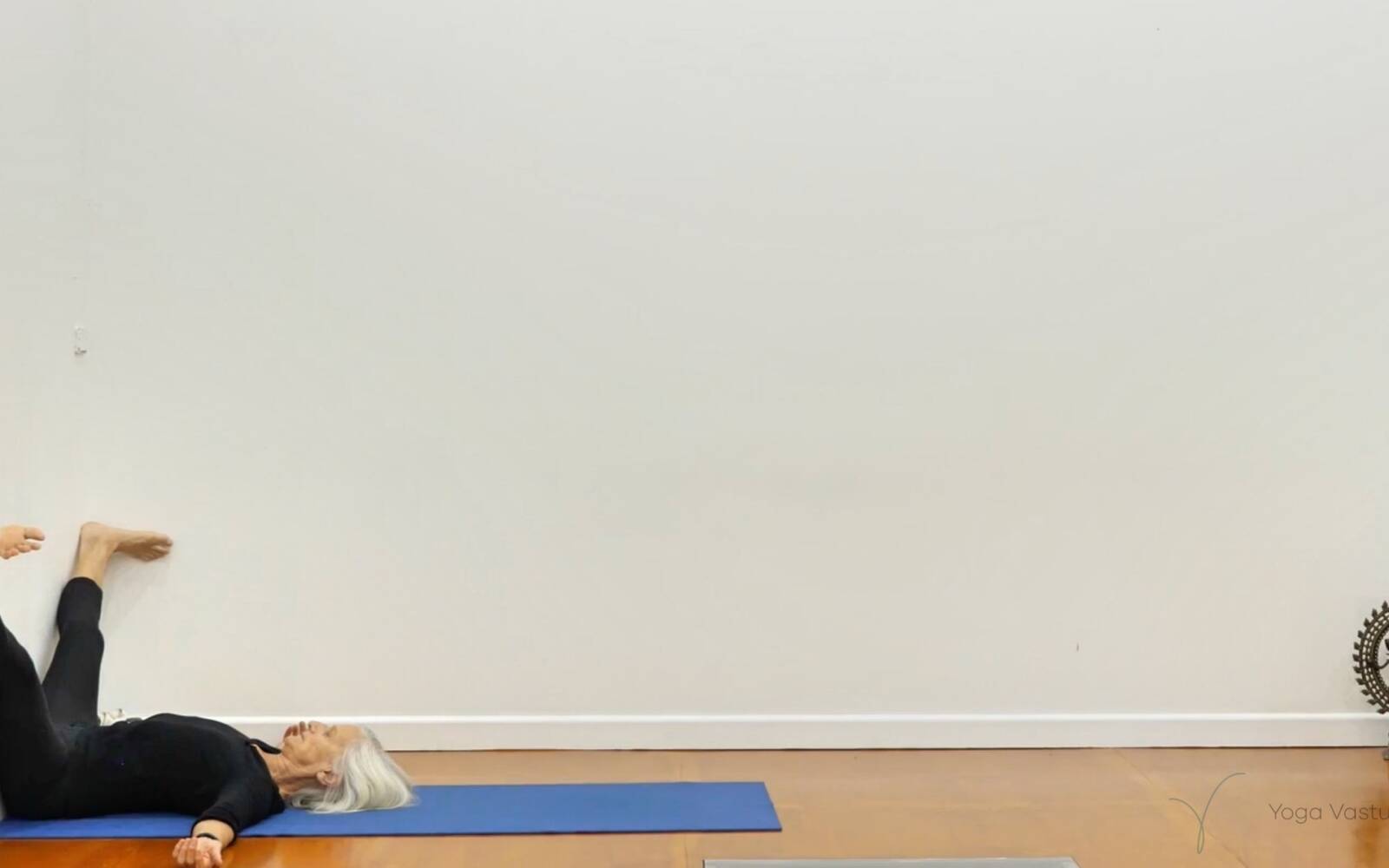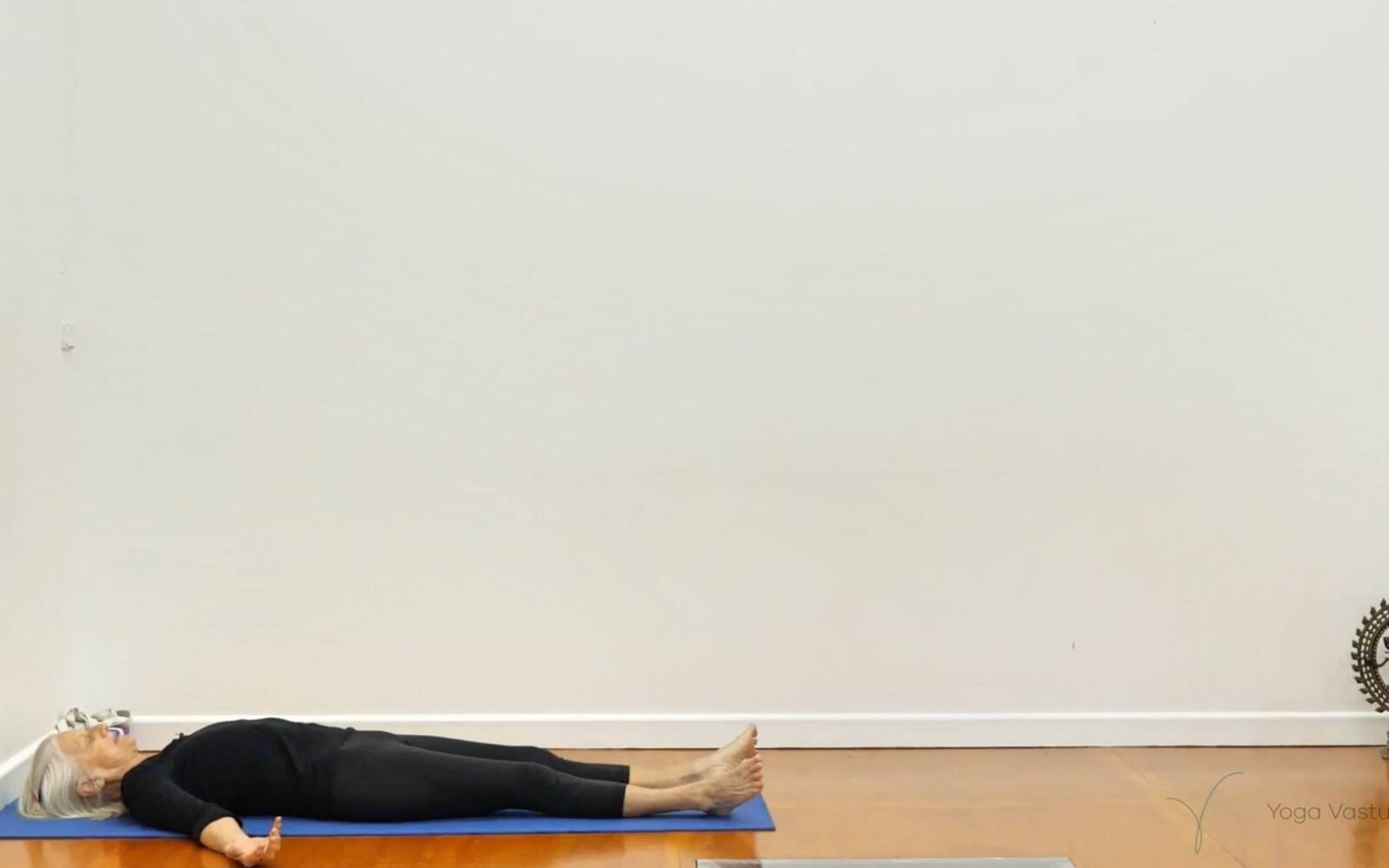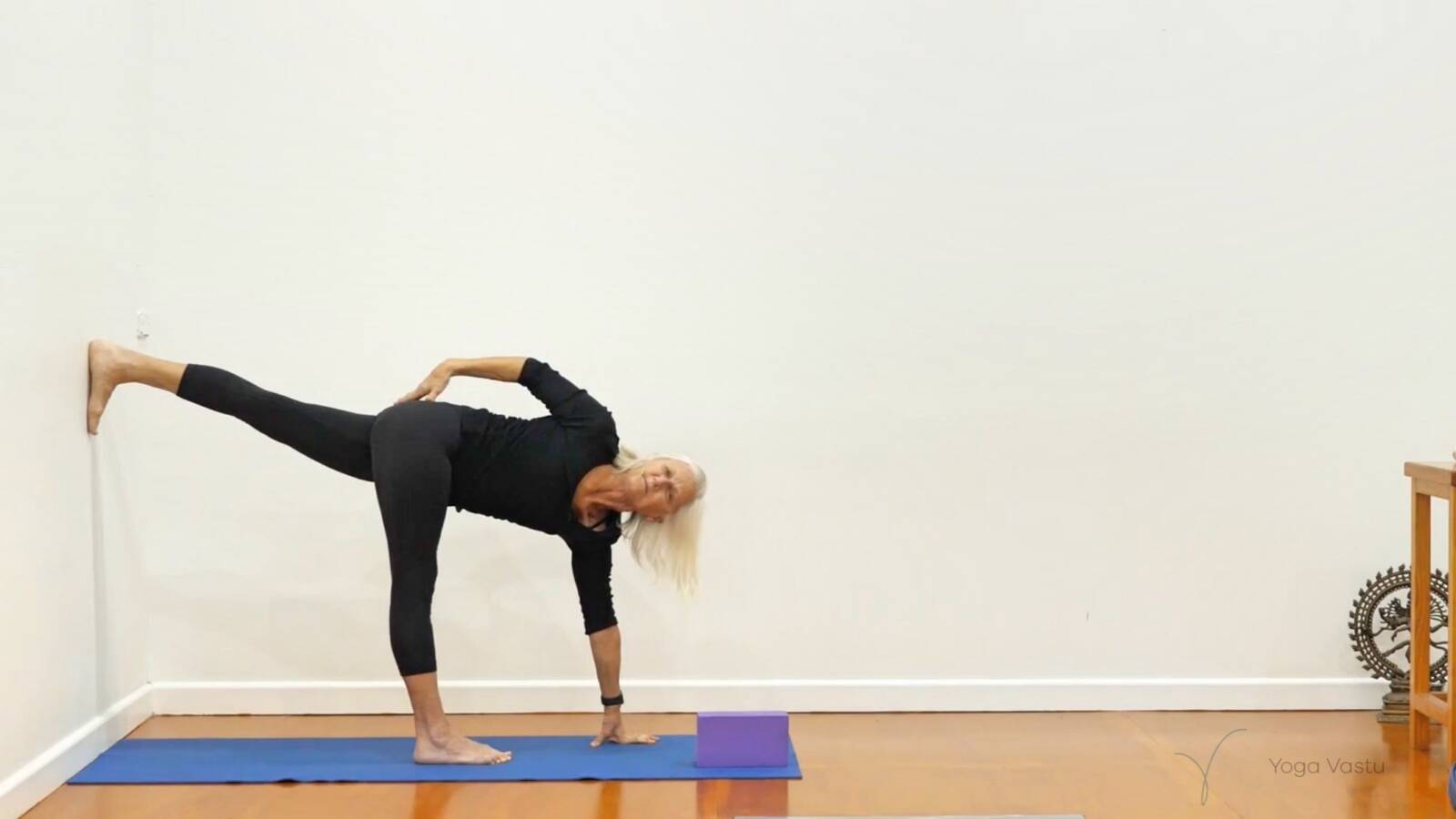In this dynamic session for lower-level students, we will focus on creating mobility and space in the hips that will also bring opening and circulation to the lower abdominal area.
Set up in Supta Baddha Konasana, lying back over a bolster with the soles of the feet against each other, the outer edges of the feet resting ontO a lengthways block. Here gravity will enhance the opening in groins and hips
Come up and bend forward in Virasana, releasing the buttocks towards the heels and extending the arms forward.
Adho Mukha Svanasana: with the hands against the wall, turning the palms out, inner thumbs and index fingers against the wall, and palms flat to the floor. Step the feet together and then raise first the R leg up, extending the inner leg long and keeping the two sides of the pelvis level. Then change to lift the L leg up.
Stand in Tadasana, facing a countertop or tall bench.
Utthita Hasta Padangusthasana 1: Lift and extend the R leg to place the heel onto the bench, with a belt around the ball of the foot. Both legs straight. Then take the belt in the L hand and move into Utthita Hasta Padangusthasana 3, revolving first to the R. Change to repeat on the L side. Keep the spine long and the legs active.
Change to Utthita Hasta Padangusthasana 2, resting the R heel onto the support in line with the middle of the L arch and looping a belt around the ball of the R foot. Keep the knees and legs straight, and turn the trunk to be facing straight forward. R buttock in. Change to the L side
Utthita Hasta Padangusthasana 4. Bend the R knee to the side and place the R lower leg onto the counter, the R sole of the foot facing out. Stand straight and allow the opening to come to the R hip.
Feel how the hip work relates to the R knee. Change sides.
Vrksasana: Stand on the L leg and place the R kneecap firmly into the wall. With the R knee fixed and stable, move the R buttock forward, keeping the trunk facing straight ahead. Knees straight. Change sides.
Place your mat lengthways, horizontally against the wall.
Step the feet one leg length apart and turn the front leg out to the R for Trikonasana. Hold the R ankle with the R hand. Turn the top shoulder towards the wall and raise the R arm up. Then look down, bend the R knee and step the R hand forward to go up into Ardha Chandrasana. Feel the support of the wall behind you so that you can turn more and take the R buttock well forwards as the L leg lifts up. Step back into Trikonasana and come up. Turn to the L side.
Now turn your mat perpendicular to the wall and come up for Ardha Chandrasana, with the R foot on the floor about one leg length away from the wall. Step into Ardha Chandrasana with the L foot firmly against the wall, toes facing out. Raise the top arm up.
Then turn the back foot so the toes are facing down to the floor and place the L hand under the L shoulder, R hand to the back pelvis. Revolve the turn keeping the legs straight: Parivrtta Ardha Chandrasana. Change sides
Now stand for Utkatasana with wall support.
Place the buttocks against the wall with feet hip-width apart. Bend the knees, keeping the knees over the heels and the back pelvis up against the wall. Hold. Then slide up and down a few times keeping the back pelvis into the wall
Malasana with wall support: squat down, using a support under the heels as needed. Bending the knees to capacity, keep the back sacrum to the wall and bend forward with the upper arms coming under the shins and place the palms onto the floor. Hold for 5-6 breaths.
Sit in Virasana, using a support under the buttocks and then, interlocking the fingers, raise the arms up in Parvatasana. Change the clasp of the hands.
Extend the legs back out into Dandasana.
Bring the feet together for upright Baddha Konasana to open across the pelvis and work into the hips. Press the kneecaps outwards and raise the spine up.
Extend the legs out into Dandasana to release any hardness from the knees.
Now lie back for Supta Padangusthasana 1 with the L foot up against the wall and a belt under the R ball of the foot. Extend the R leg up towards the ceiling. Then open the R leg out to the side, placing the R foot firmly against the wall. Feel the extension of the R leg away from the body. Observe the connection of the R leg back into the R hip.
Supta Padangusthasana 3: Bring the R leg up and change hands, the L hand now holding the belt to take the leg across the body.
Supta Padangusthasana 4: bring the R leg back up and, bending the R knee and elbow out to the side, lift the head and take the R forearm under the back of the head. Observe the actions created in the R hip. L leg straight and foot into the wall. Change sides.
Now some of those same hip-opening poses can be repeated more passively with the support of the wall and floor.
Sit with R side of the hips up against the wall and lie back, swinging the legs up along the wall, keeping the whole back and head onto the floor.
First keep the legs upright, with the back of the buttocks and thighs firmly against the wall.
Next, draw the feet down into Baddha Konasana, and hold for around a minute. Let the knees open out towards the wall. Notice how the knees open more easily when you have the whole back supported by the floor and the spine is kept long.
Then open the legs out to the side in Upavistha Konasana. Observe the opening that comes into the inner legs and groins. Keep the knees straight.
Bring the legs back to 90 degrees, and then bend the knees towards the chest. Hold for a few breaths before turning to the side.
Lie back in Savasana. Keep the eyes and face quiet as you internally observe the effect of the hip opening poses you have just done.
Video stills from this sequence
